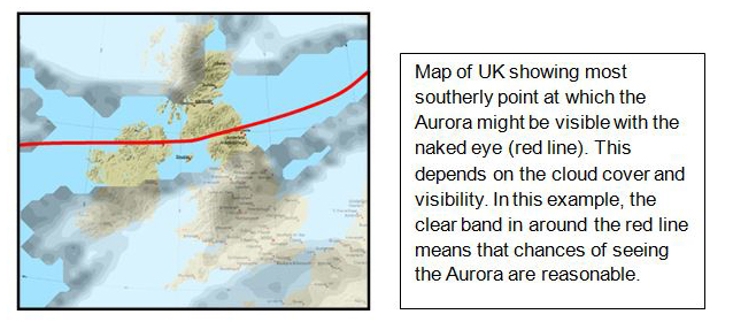Auroras
Information about the auroras - what are they and when are you likely to be able to see them...
When and where are you most likely to see the Northern Lights?
As the UK is south of where the natural aurora belt occurs (Norway/Iceland/Greenland), it takes a severe or extreme geomagnetic storm (Kp8-9+) to bring the belt southwards directly over the UK. This is a very rare occurrence. During more moderate to strong geomagnetic storms (Kp6-7), the Aurora borealis often moves southwards across southern Iceland or towards the Faeroes. These auroras can be faintly visible from the UK because they occur at high altitudes.
The Sun goes through an 11 year solar cycle, from solar minimum, through solar maximum and back to solar minimum. Solar maximum occurred in early 2014 so we are now in the declining phase of the solar cycle. During this phase the position of coronal holes on the Sun's equator give rise to high speed solar wind streams that buffet the Earth, disturbing the Earth's magnetic field and increasing the likelihood of auroras. In other parts of the solar cycle these disturbances are largely the result of coronal mass ejections, which can give larger magnitude disturbances than these high speed streams.
Auroras photos versus the naked eye
The Northern Lights can produce a spectacular light show sometimes seen as far south as Scotland and Northern England/Ireland - if skies are clear. The distance to the aurora belt, compounded by light pollution or twilight, means it can be difficult for the naked eye to see the phenomenon clearly and it is often portrayed much brighter in pictures than it appears to the naked eye.

Photos of the auroras can seem unrepresentative of what you can see with the naked eye. This is simply the result of how the photos are taken. Photographers use the same equipment and techniques used to capture dimly-lit features which are barely visible to the naked eye, such as the Milky Way.
This usually means using a tripod and a long exposure length. This allows an excess of light into the camera producing a brighter image of the event. In addition, the slow movement of the aurora across the sky can further exaggerate the picture creating blurred streaks and making the Northern Lights appear like a green or red glow along the northern horizon.
Tips for seeing the aurora
- You need a clear night with no cloud cover
- Find a dark location with no light pollution
- Look toward the northern horizon
- Be cautious that geomagnetic activity can cause disturbances to satellite navigation (GNSS/GPS etc)

Coronal hole
A low density region of the corona with relatively low temperature. Coronal holes are the sources of high speed solar wind streams.
Coronal Mass Ejection
An ejection of material from the Sun into interplanetary space. If the material is directed towards the Earth then the event may result in a disturbance to the Earth's magnetic field and ionosphere.





